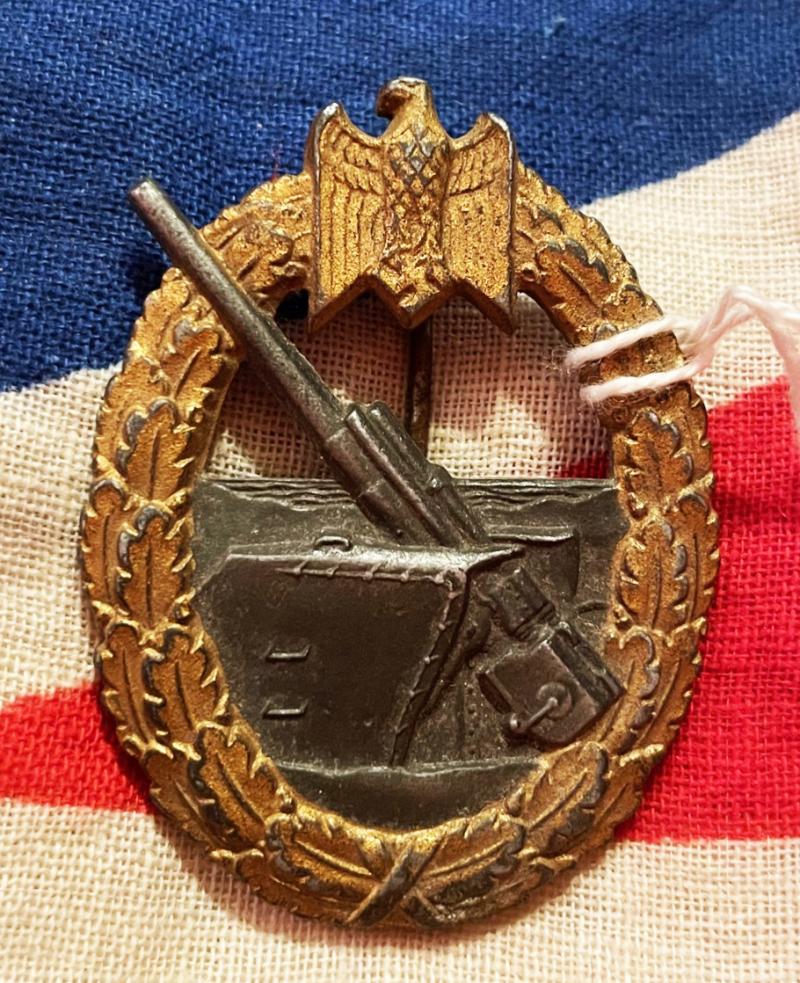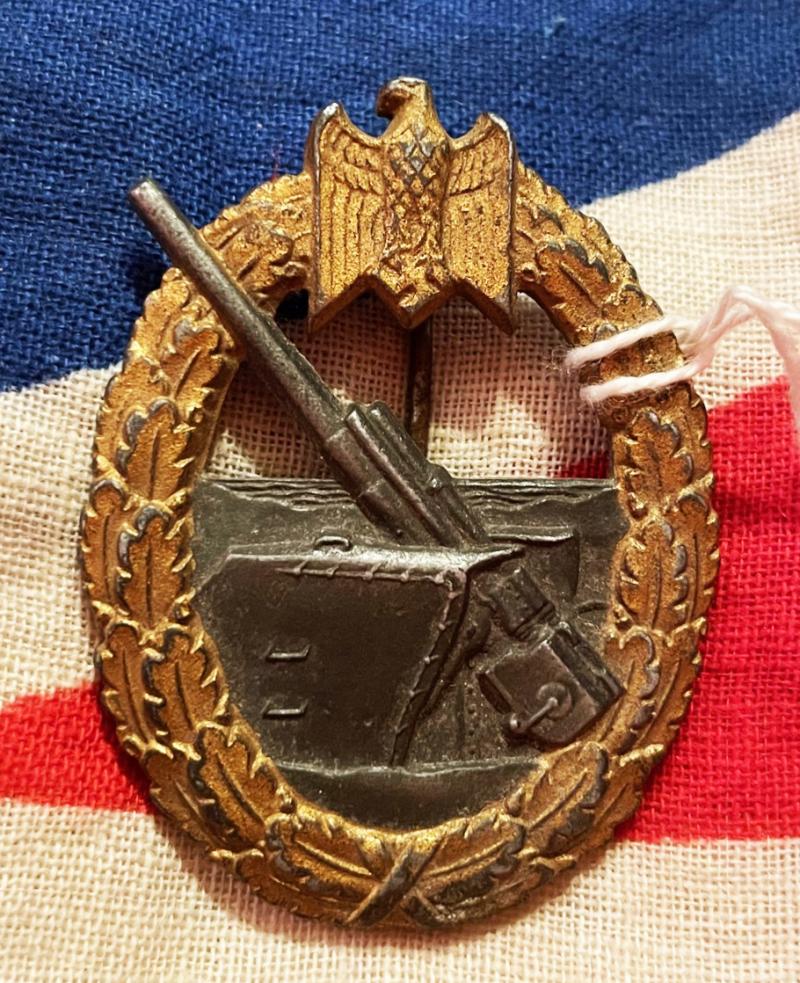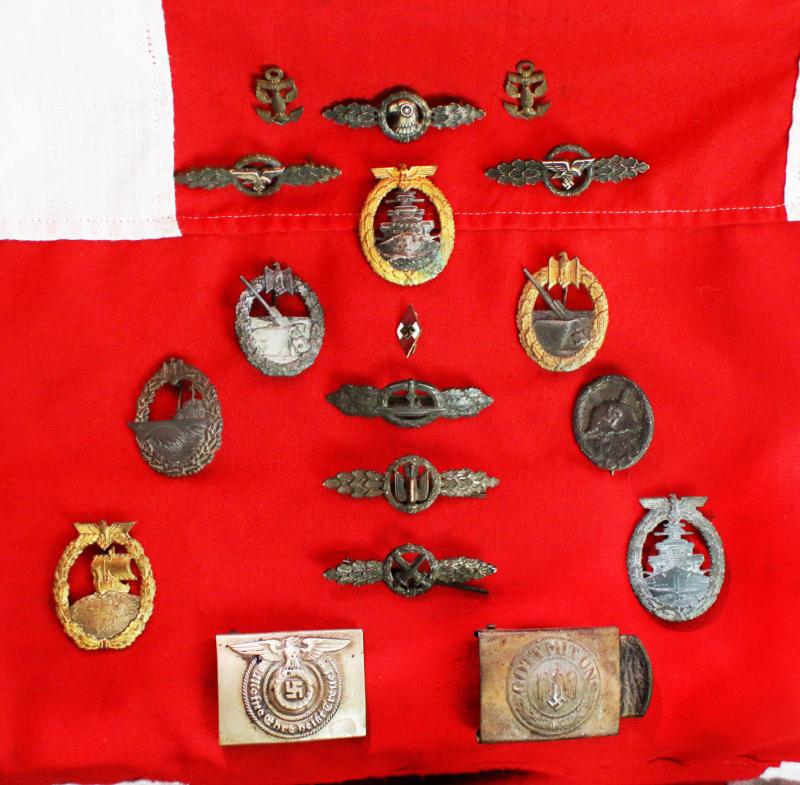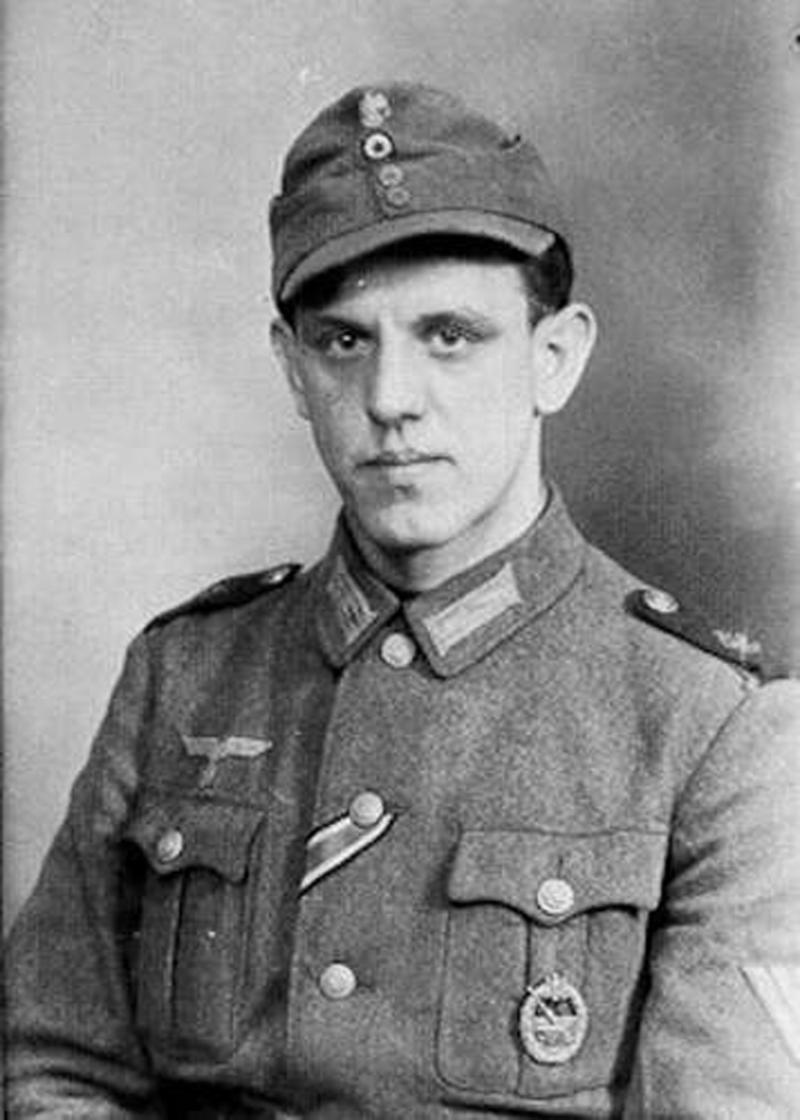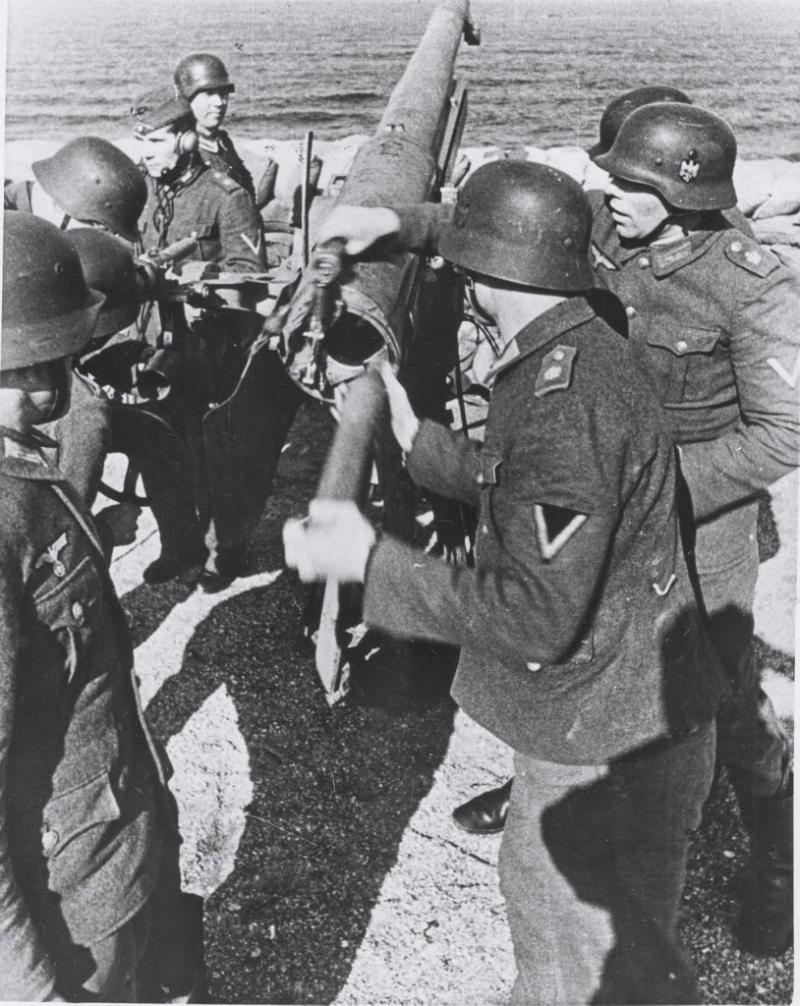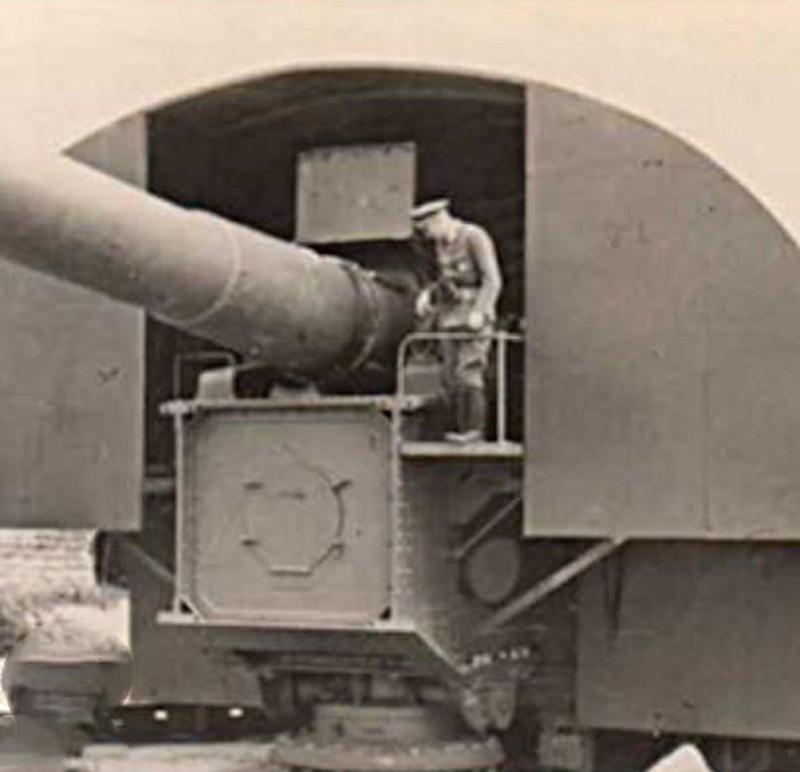A Very Good Original, WW2, Kriegsmarine Coastal Artillery Combat Badge Kriegsabzeichen für die Marineartillerie By Friedrich Linden of Lüdenscheid. From One Of Ian Fleming’s Naval Intelligence Section’s So Called ‘Red Indians’ 30 Commando Special Engineer
An original Kriegsmarine Coastal artillery badge by by FLL 43 – Friedrich Linden of Lüdenscheid constructed in zinc with nice gilt finish. . A zinc produced piece with a great amount of gold finish remaining. The Kriegsmarine maintained a large ground force, organized along the same lines as the German Army, which was known as the Marine-Infanterie . Kriegsmarine naval artillery and anti-aircraft crews were considered as shore personnel. Artillery units were organized into either regiments or sections while flak units were maintained in brigades and regiments. Both types of units were assigned to various ports and harbors and thus were under the direct operational authority of both the port commanders as well as the commander harbour security forces. During actual invasion of coastal regions by enemy forces, these units became part of the sea defense zones.
The Naval Artillery War Badge or War Badge for the Coastal Artillery (German: Kriegsabzeichen für die Marineartillerie) was a World War II German military decoration awarded to the crews of Kriegsmarine land-based marine artillery and anti-aircraft units. It was presented to personnel of coastal defense units, and anti-aircraft units. The award was instituted on 24 June 1941 by Grand Admiral Erich Raeder to reward the actions of both individuals and crew members. It was also awarded to those killed in action in said units.
Originally taken by a commando of 30 commando X troop while on clandestine missions as part of 30 Commando reconnaissance and sabotage.
From a former special engineering unit {Ian Fleming’s so called ‘Red Indians} in wartime Europe were a vital part of clandestine warfare, and all parts of the units combat service were then trained in recognising enemy mines, booby traps, handling of explosives, demolitions, counter-demolitions, bomb disposal, and combined with recognition of enemy uniforms and equipment for intelligence gathering. Reporting all elements of their findings back to CoCO, and by them to the Admiralty. Fleming referred to such brave men as his ‘Red Indians’. see Casino Royale for reference.
There were seven active Marinekustenten-Bataillons or MKBs consisting of two to six companies each, prior to the invasion of Norway. These battalions were charged initially with protecting the coasts and harbors of Germany. With the fall of Norway, France, and the Low Countries, these units were expanded to include four large-caliber naval batteries between Calais and Boulogne. These were to be used during the planned invasion of Britain to provide the initial shore bombardment of the Dover Area and prevent the Royal Navy from interfering with the invasion fleet.
When the invasion was scrubbed in late 1940 in favor of starving Britain into submission, additionally Navy Artillery and Flak companies were formed to protect the many U-Boot bases being built along the Atlantic Coast. In mid-1941, battalions were formed to fortify the Channel Islands and the coast of Norway.
Artillerie of HKB was responsible for “Filling-In” the coastal areas between these points by covering possible landing sites. The Navy Artillery units were normally situated directly on the coast and used as direct fire control procedure similar to that used on ships, with the Army positioned further inland, which protected them from Allied “Air” and “Naval” attack, but limited their ability to track and engage enemy ships and landing craft. Navy artillery battalions were separate from the Heer, under the Navy.
Battery organization generally depended on the weapon system to which Fuhrer Directive 40, March 1942, provided detailed instructions for the construction and defense of what became known as the Atlantic Wall. This meant a massive expansion of the Naval Artillery, with some 100 Battalions* created by the end of the war.
Navy (Kriegsmarine) units were primarily deployed to defend, important ports, or harbors, rivers, estuaries, and other points critical to naval operations.
The brain child of naval commander Ian Fleming & Lord Louis Mountbatten, 30 Commando, this wartime unit was a secret well kept for over 50 years after the war by the Official Secrets Act, some remains classified. At the time, officially, they didn’t exist. The members of this unit were forbidden to discuss or document their activities, a pledge that many of the men kept even many years after the war was over, or even for their entire lives!
Due to the fact these men operated in very small groups on ‘need-to-know’ basis it is very difficult to get clear picture of everything they were doing.
Fleming’s/NID30AU secretary Miss Margaret Priestley (a history professor from Leeds University) played a vital role in the running and administration of 30AU and became his inspiration for Miss Petty Pettaval - the original character name that became Miss Moneypenny.
As revealed here for the first time! (see Beau Bête)
Miss Preistley transferred over to NID30AU during the winter of 1943-44 from DNR - (Department of Naval Research) where she worked as a civilian, although there were obvious links between DNR and NID30AU as intelligence on enemy targets was collected for Fleming’s ‘Black List’.
Also Known as: Fleming's 'Red Indians'
Fleming himself referred to the men of the unit as behaving like 'Red Indians'. (A reference he also used when referring to his character, James Bond, four times in his first novel Casino Royale. Which effectively makes this unit the ‘literary James Bond’s wartime unit’.)
Formerly:- (NID30 Command Office at Admiralty),
Special Engineering Unit.
'RED' Marines.
Latterly:- 30 Assault Unit,
30 Advanced Unit, 30AU
and incorrectly as 30th Assault Unit.
The number '30' was used for no better reason than it was NID/Miss Priestley’s Office Door number at the Admiralty. (Fleming’s Office was No. 39, see photo in the gallery of Fleming in room 39 of the Admiralty) 'Assault Unit' was 'overt' cover for the fact that they were intelligence gathering.
Date Founded: 30 September 1942
Date Disbanded: 26 March 1946
Date Reformed: February 2010 - 30 Cdo IXG
Mission When Founded:
The collection of technical intelligence and personnel from enemy headquarters and installations. Ahead of allied advances and before enemy could destroy it, to ‘Attain by Surprise’.
30 Commando consisted of Royal Marine, Army and Royal Navy elements that were organised into three Sections: No. 33, No. 34 and No.36 respectively. Initially code-named the Special Engineering Unit, the unit reported to the Chief of Combined Operations, though the Admiralty retained ultimate control of No.36 Section. No.35 Section was left vacant for the RAF to utilise but they never raised a troop to participate in 30 Cdo. Although they did supply intelligence officers and specific targets to pursue after D-Day for ‘Operation Crossbow’.
Unit members were given general commando skills and weapons training, and were then trained in recognising enemy mines, booby traps, handling of explosives, demolitions, counter-demolitions, recognition of enemy uniforms and equipment. Parachute training, small boat handling, recognition of enemy documents, search techniques including lock picking and safecracking, prisoner handling, photography and escape techniques were also taught.
A significant number of the initial recruits were formerly policemen. Although at least one ‘expert’ was recruited straight from prison, thought by the police to be the best safe-breaker in England at the time.
30 Cdo’s operational tactic was to move ahead of advancing Allied forces, or to undertake covert missions into enemy territory by land, sea or air, to capture intelligence, in the form of equipment, documents, codes or enemy personnel. 30 Cdo often worked closely with the Intelligence Corps' Field Security sections. More often than not each team consisted of two special operations Jeeps (As used by the SAS and 30AU) manned by one Naval Commander in possession of a ‘Black Book’ which listed targets from Ian Fleming’s famous ‘Black List’. The Naval Commander was the only man in each team who knew where and what the targets actually were. This Naval Commander was usually accompanied by at least one weapons expert or scientist who he relied on to evaluate the information or equipment they encountered. There were also usually at least six Royal Marines and one RM Officer whose main job was to do any fighting required and to keep the Naval Commander and any experts alive and out of trouble. (For details Reading section.)
The individual Sections served in all the Mediterranean and NW European operational theatres, usually operating independently, gathering information from captured facilities. The unit served in North Africa, the Greek Islands, Norway, Pantelleria, Sicily, Italy, and Corsica, 1942-1943 as 30 Commando.
As the Allies broke through 30AU split into many ‘Field Teams’ and these were responsible for capturing many and varied targets throughout Germany.
Team 2 under Curtis captured Prof. Helmut Walter, designer of the Me163 Rocket Plane and Midget Submarines at Kiel. (Kept by the British!).
Team 5 under USN Lambie captured Prof. Herbert Wagner (Handed to US Agents) designer of the guided flying bomb Hs293, already used to sink HMS Egret and to kill over 1000 troops on HMT Rohna. He went on to work for the US Navy. He did not surrender in Bavaria with Dornberger and the von Braun brothers as the Allied military would have us believe..
The capture of Prof. Magnus von Braun (Martin) V2 fuel chemist. (Handed to US Agents). He did not surrender in Bavaria as the Allied military want us to believe.
The capture of the designer of the Nazi V2 (who went on to the NASA Saturn V), Prof. von Braun and his brother. (Some men were convinced they were some of the scientists they caught!) Did they surrender in Bavaria as the Allied military want us to believe or was that staged afterwards? (see Beau Bête for details and FREE preview PDF, in Reading)
Team 55 under Glanville captured the entire Nazi Naval records collection at ‘Tambach Castle’.
Team 4 under Job(e) captured the Bremen dockyards with type 21; 25 submarines and destroyers. Then took the surrender of Bremerhaven and captured Naval HQ SS Europa and Z29 Destroyer. (All handed over to US Agents).
Team 2 Postlethwaite captures the Torpedo testing facility at Ekenförde.
Another team captured Admiral Dönitz (as Führer).
And many other things yet to be revealed by the government!
Ref; https://www.30au.co.uk
An amazing historic collection of information, including. https://www.amazon.co.uk/Beau-B%C3%A9te-assigned-Flemings-intelligence/dp/B08R7XYHXW
Every single item from The Lanes Armoury is accompanied by our unique Certificate of Authenticity. Part of our continued dedication to maintain the standards forged by us over the past 100 years of trading
Code: 25712
450.00 GBP

